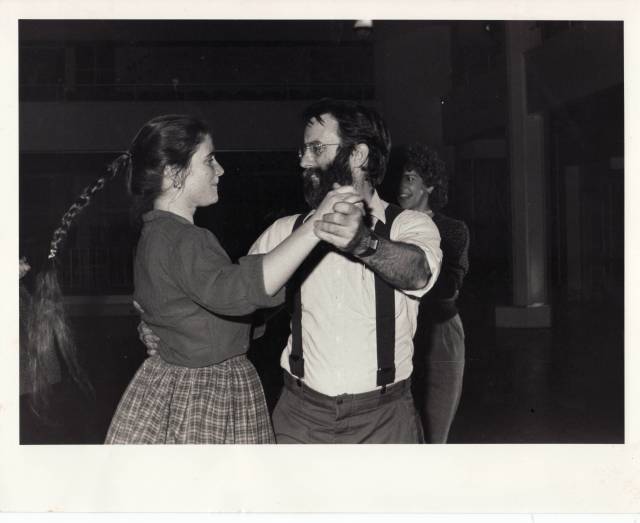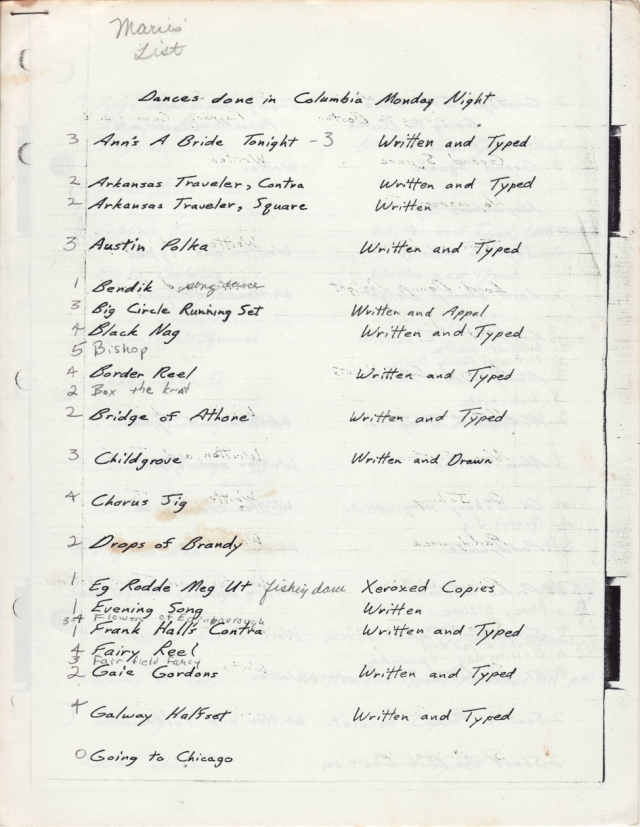Chapter 2 – Stephens Ballroom – 1980 to 1985
Dancing at the Lela Raney Wood (LRW) ballroom of Stephens College started in 1980, still on Mondays, and went until 1985.
 Hank and Elisabeth dancing at Lela Raney Wood ballroom circa 1982.
Hank and Elisabeth dancing at Lela Raney Wood ballroom circa 1982.
Because the group was fairly small, about 20, and Stephens ballroom is a huge room that can hold 200 or 300 dancers, the lines were in the short direction, facing the small stage by the windows. The combination of contra, English, and Irish dancing proved to be challenging. Right from the beginning, contras became more popular than Irish dancing. However a small number of people was dedicated to Irish dancing and fairly quickly, Irish and contras took off separately: Irish on the 1st and 3rd Mondays and American contras on the 2nd and 4th. The infrequent fifth Monday might have been a combination.
 1980 flyer inviting people to come dance Irish and Contra dances at Lela Raney Wood ballroom.
1980 flyer inviting people to come dance Irish and Contra dances at Lela Raney Wood ballroom.
Besides the split between Irish and American contra, another split started to take shape. Some came as much for social interaction as for dancing. Others wanted to become better dancers.
Social interaction was taking place behind the musicians and caller, by the windows. Personal lives were intertwined with dancing. On the happy side, the weekly dance was a venue for courtship and many pairings of people occurred. This perhaps is the ageless story of dance and dance groups. The dance group was also a support group, for people going through a divorce, or separation, or having problems. Those sadder stories are perhaps better kept in the shadows but in any case there was drama, and with drama a lot of talking.
Given that there was no sound system per se, the chattering was, at times, louder than the voice of the caller. So it was difficult for the caller to be heard and those resorted sometimes to some expletives in order to get some quiet. The shock would do the trick but that was no way to go about it. So Hank invested in a microphone for the ballroom — one that you could plug in a little built-in sound system. There would be one small microphone and a huge room. And it was still better than nothing because of the poor acoustics of the ballroom.
Dancers who came more for the dance than social interaction wanted to dance well. They did not want to be professionals but they wanted to dance Irish sets. So they formed a Irish dance performance group (it did not have a name even though people now and then asked for one). They would meet on Sundays and work on polishing moves such as Diamonds and Squares so that it would flow very well. This is how dancing got on one of the very early episode (show #30) of the “Pepper and Friends “ show, aka the Paul Pepper show, a half-hour, live audience pre-taped TV show filled with community happenings, which began in 1982.

This was prepared in advance: the tunes and the dances (The Duke’s Reel and Eight hand reel) were rehearsed and the dancers made costumes. Clare Connors played piano and Dan Leonard played tenor banjo. They danced those two dances in between interviews of a woman talking about the doll houses she was making (with a doll in a bathtub full of Champagne) and a law enforcement officer talking about lie detectors. After that, they kept dancing Irish dances and performing in public places for a few years.
For the American contra dance, the type of dances in vogue during that time in Columbia included a mix of English country dances, older and a few modern contra dances, as well as chestnuts and others. Contra dancing was new, people were learning how to dance without an experienced pool of people, and teaching generally required more time than it does now. There was a very small number of callers, including Deric Owens and Chris Griffith. Others called at times, for example Marie, Hank Taylor, or Bill Connor and Betty Baker. Both Marie and Deric were calling traditional dances.
Gene Hubert started to dance in Columbia. According to him, (Author’s notes of Dizzy dances Volume II) Gene walked into his first contra dance in the fall of 1980, thus at the ballroom. Dancing was new to him and he was a beginner, just like all of us have been at some point. In five years, he “became a regular dancer, dance caller, dance composer and aspiring dance musician”. Gene published his first volume of dizzy dances in 1983, followed by Volume 2 in 1986 and Volume 3 in 1992.
There were less resources for learning to call and for teaching: no internet listserv for callers, only a few books. The way callers learned new dances was to go to dance weekends and travel to other venues. Hank and Marie and many of the dancers knew and had experienced the Kimmswick weekend and the Berea school of dance. Once callers knew each other well enough, they might exchange dances and advice through regular postal mail. Gene Hubert was known at the Barn dance in Chicago. He certainly shared his dances there but he probably learned some as well, at least in the beginning.
Musicians were hard to find as well. Some of the musicians who made Swoop were still playing a lot for dances, even for American contras, and Banshee, a woman only music group (Becky Pringle, Becky Moody, and Carol Goodnick) is remembered by many. Dave Para and Kathy Barton continued to play for dances. But sometimes, there would not be more than one or two musicians, someone playing the fiddle or someone with a penny whistle. Eventually, various other non-Irish musicians started to show up for the American contra: Spence Galloway, a very good fiddler who always used to play in contests and who already played for the dancers at the Chez, or Heinrich Leonhard. The enticement was not money: there was no admission fee, no money in the group, just the hat passing around for a little contribution toward the musicians and caller.
In 1977, Paul Fotsch was learning the fiddle and Win Horner (then his wife, now Win Grace) was learning the accordion. They were playing for fun. They had never thought about dancing or playing for dances but Gene Hubert came to their (Win and Paul) house. He explained what contra dancing was, the AABB structure of the tunes and they tried out a few songs. Gene schooled them. After more practice and playing for fun for a few years, Paul and Win played for a dance, probably at the ballroom. Later, after a tour that took them to Colorado and other places from which they came back with more money than they had left with, Paul and Win decided to make their living playing music. They played for contra dances in Columbia from that time until around 2010.
With regular dancing, people started to see the need to attract new dancers and publicize. Art Jeffrey was first introduced to dancing because of a health fair at the university. Dancers were there advocating the benefits of dancing and invited participants to come back to the fair in the evening, when dances would be taught. So Art went and danced and had a wonderful time. And when someone announced the dances at Stephens, Art made a note of it, went there, and had a wonderful time. To make things easier on parents with young children, there was an attempt to organize child care during the dance. Free of charge for the dancers, one or two parents would take care of all the children on a rotating basis. However, the convenience got abused by people dropping their children and leaving the ballroom; it was quickly abandoned.
There was no money. There were no officers. But someone always took on the responsibility of making sure the venue was open, that there would be a caller and musicians, of advertising, and doing outreach. Names and contact information of all the dancers had to be collected and kept on file for informing them of dances, sending occasional newsletters, and giving last minute information such as cancellation. There was neither email nor facebook. Instead, a calling tree was in place to reach people by phone. In the early 80’s, many dancers helped at different times, often some of the people who called (Chris, Marie or Deric) but others as well. Then gradually, Jim Ronald took on more and more responsibilities and by the mid 80’s, he had a prominent role.
At some point, Stephens decided that the group could not continue dancing in the ballroom. According to Michelle Emery, there might have been an insurance question. Stephens College wanted the group to have insurance in case someone hurt themselves while dancing but insurance was not affordable for the group. Others indicate that Stephens wanted to close the ballroom as a cost saving measure. We place the end of the Stephens dances in or after June 1985, from an Missourian article showing Paul and Win playing for a dance there. After the ballroom was no longer available, dances were organized for a while in Stephens’ Senior Hall on the third floor. That had to stop though because there was a serious concern that the floor would collapse with the dancing. For a while, the group sort of drifted around, happening whenever a venue was available. For a very short time, the group met in the Tate Hall gymnasium at MU. The Missouri United Methodist Church downtown was also one of these places, but the group slowly disappeared. Then it died out completely. It went away….


First page (out of 4) of the list of dances for the Columbia’s Monday Night dances.
